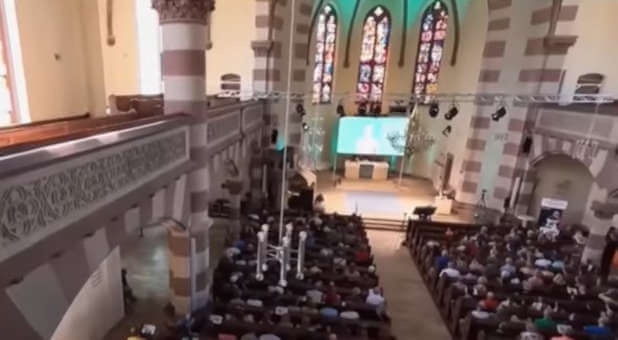Artificial intelligence appears to be conquering the secular world. But now the church?
It was only a matter of time, wasn’t it?
The Associated Press reported that a ChatGPT chatbot, in the form of an avatar of a bearded black man on a huge screen above the altar, led an experimental Lutheran church service last week as part of the Deutscher Evangelischer Kirchentag convention in Fuerth, Germany. Almost entirely generated by AI, the service was attended by 300 people and drew such immense curiosity that a long line formed outside the 19th-century, neo-Goth church an hour before it began.
The convention takes place every two years in the summer at a different place in Germany and draws tens of thousands of believers to pray, sing and discuss their faith.
The service began when the chatbot asked attendees in the fully packed St. Paul’s Lutheran Church to rise from the pews and praise the Lord.
“Dear friends, it is an honor for me to stand here and preach to you as the first artificial intelligence at this year’s convention of Protestants in Germany,” the AP reported the avatar said with an expressionless face and monotonous voice.
The service lasted 40 minutes—including prayers and music. The entire event was created by ChatGPT and Jonas Simmerlein, a theologian and philosopher from the University of Vienna.
“I conceived this service—but actually I rather accompanied it, because I would say about 98% comes from the machine,” Simmerlein,told The Associated Press.
“I told the artificial intelligence ‘We are at the church congress, you are a preacher … what would a church service look like?'” Simmerlein said. He also asked for psalms to be included, as well as prayers and a blessing at the end. You end up with a pretty solid church service,” Simmerlein said.
The AP reported that attendees of the church service listened attentively to the AI preacher, who spoke about “leaving the past behind, focusing on the challenges of the present, overcoming the fear of death and never losing trust in Jesus Christ.
At least the chatbot got the last part correct, which almost any human preacher with a solid relationship with the Lord would tell you.
The entire service was “led” by four different avatars on the screen, two young women, and two young men. At times, the AI-generated avatar inadvertently drew laughter as when it used platitudes and told the churchgoers with a deadpan expression that in order “to keep our faith, we must pray and go to church regularly.” The AP reported.
The service itself, and the AI leadership during the service, drew mixed reactions from the crowd in attendance. Some people enthusiastically videotaped the event with their cell phones, while others looked on more critically and refused to speak along loudly during The Lord’s Prayer.
One attendee, who works as an IT person, said she was excited and curious when the service started but found it increasingly off-putting as it went along.
“There was no heart and no soul,” she said. “The avatars showed no emotions at all, had no body language and were talking so fast and monotonously that it was very hard for me to concentrate on what they said. But maybe it is different for the younger generation who grew up with all of this,” she said.
A young Lutheran pastor who brought a group of teenagers from his congregation in the western German city of Cologne, were a bit more intrigued by the service.
Marc Jansen, a 31-year-old Lutheran pastor from Troisdorf near the western German city of Cologne, brought a group of teenagers from his congregation to St. Paul. He was more impressed by the experiment.
“I had actually imagined it to be worse. But I was positively surprised how well it worked,” says Jansen. “Also, the language of the AI worked well, even though it was still a bit bumpy at times.”
Jansen, however, said he missed any kind of emotion or spirituality, which he says is essential when he writes his own sermons.
Shawn A. Akers is the online editor at Charisma Media.












